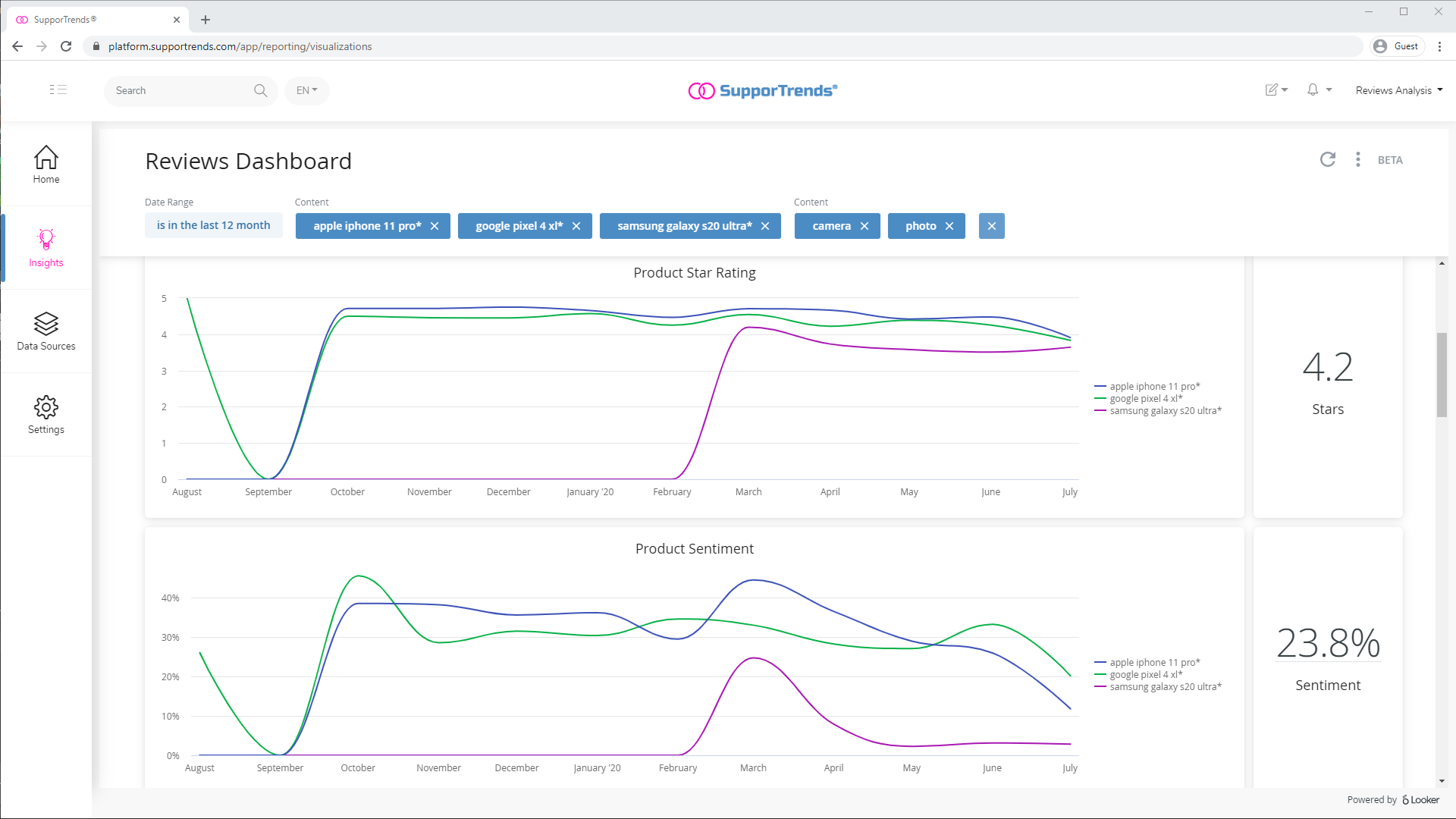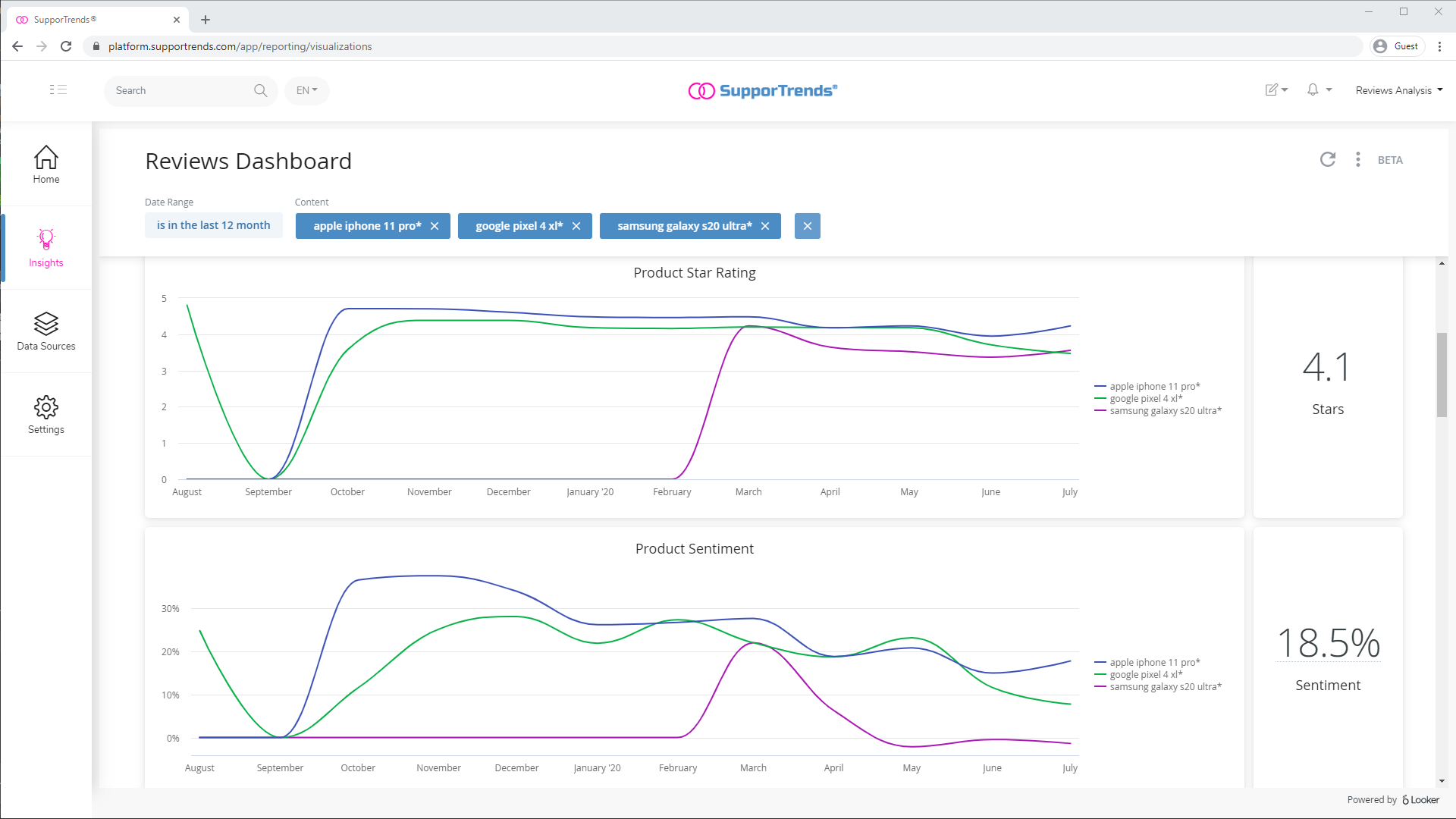Who Makes The Best Smartphone Cameras?
You’d be forgiven for thinking that this article might be another copy-and-paste spec sheet comparison designed to rank at the top of a popular Google search. After all, what does SupporTrends know about cameras?
Let me assure you that this is a hands-on review...with a twist. Instead of sharing the perspective of one reviewer, like myself, with whatever agenda or biases I may have, we’re going to share the cumulative perspectives of 1,500 people.
This “Best of” feature is written by you, the actual user, made possible by SupporTrends’ fast understanding of actual customer feedback. In Part 1 of this series, our platform is going to analyze publicly-available reviews for the Apple iPhone 11 Pro, Google Pixel 4 XL, and Samsung Galaxy S20 Ultra 5G to determine what customers love and hate about the cameras in each of these smartphones.
But first, we should get some specs out of the way:
Apple iPhone 11 Pro
3 Rear Cameras: 12 MP (wide angle), 12 MP (normal), 12 MP (telephoto)
Front Camera: 12 MP
Google Pixel 4 XL
2 Rear Cameras: 12.2 MP (normal), 16 MP (telephoto)
Front Camera: 8 MP
Samsung Galaxy S20 Ultra 5G
3 Rear Cameras: 12 MP (wide angle), 108 MP (normal), 48 MP (telephoto)
Front Camera: 40 MP
How we did it
We processed the top 500 Google product reviews for each model listed above (which meant phones that did not have at least 500 reviews could not be included). Google sorts these reviews in various magical ways, so while we have, presumably, the top 500 most relevant reviews for each product, we did not process all reviews for each product.
To process the reviews, we used SupporTrends’ simple CSV file upload tool, which can be used to supplement the automatic streams of data from our Zendesk, Kustomer, and various other APIs.
Now Let’s Explore
A few minutes later, after the files are processed and the qualitative feedback is automatically organized, we merely need to select the products we want to analyze. Simple!
Right off the bat we notice that the Product Star Rating starts at zero and begins to register when each product launches. The Apple iPhone 11 Pro reviews come online in September 2019, Google Pixel 4 XL in October, and the Samsung Galaxy S20 Ultra in March of this year. This data set as a whole averaged 4.1 stars over the last year.
It’s also interesting to notice that in all three traces, the early reviews show a higher average star rating than the later reviews do. The most pronounced drop belongs to the Galaxy S20 from 4.2 stars at launch to about 3.5 stars by the end of June.
But while star ratings are certainly useful, especially when tracking trends as shown above, they can be somewhat monotone since so many products end up in the 4-star range.
To solve for this, the SupporTrends platform automatically analyzes the sentiment contained in the review language as well, as its range is much more dynamic. Sentiment is also completely detached from the star rating chosen by the user, diving directly into the essence of how customers feel, and ultimately what they are looking for.
As is the case with Star Rating, Product Sentiment starts high at launch and then tapers off. Again, too, the Galaxy S20’s sentiment falloff is the most severe, dropping from the 20% range to below 0% / neutral about two months after launch.
The Cameras
Alright, we said that was a camera review, right? That’s right! Now it’s time to jump into the structured language analysis (which we proudly and uniquely offer). It turns out that the camera is the most talked-about feature for all of these phones with 537 reviews containing camera feedback (roughly 36%), and another 88 talking about photos. And most of it is positive. Let’s dive in by selecting “camera” and “photo” from the dashboard.
We can also see that the sentiment curves change when we select the camera features. On average, they jump from 18.5% (for all phones, all reviews) to 23.8% (all phones, camera-only reviews), a not-insignificant 29% increase. So, generally speaking, the camera feature draws the average scores upwards.
Customers like this feature more than the rest of the phone.


Highlighting the challenges with star ratings, where important details can get lost in the averages, the star rating moves only slightly, from 4.1 to 4.2 stars. Let’s take a look at the individual breakdowns for each device.
Apple iPhone 11 Pro
The iPhone 11 Pro’s baseline scores are quite high at 4.5 stars and 29% sentiment, which is understandable as we all know iPhone customers love their devices. This already-high score improves to 4.6 stars and 35.2% sentiment when viewing only the 287 reviews that mentioned the camera.
Google Pixel 4 XL
While slightly lower than the iPhone 11 Pro, the Pixel’s average star rating of 4.2 is still not bad, though its sentiment score of 22.5% is noticeably lower. When removing the non-camera reviews, the remaining 252 reviews increase scores to 4.4 stars and 29.8%.
Samsung Galaxy S20 Ultra 5G
This phone scored surprisingly low in most user reviews. Its 3.6 star rating was worst of the bunch, as was the 3.8% sentiment score. Focusing on the 299 camera reviews brings those scores up to 3.7 and 7.9%.
Quantifying Specific Camera Feedback
Diving in a bit deeper, we can isolate and quantify the passion with which consumers speak about the cameras on each device.
Apple iPhone 11 Pro
Most (240 of 287, or 84%) of the iPhone 11 Pro camera reviewers mentioned the camera or photos in a positive light, with average sentiment scores of 85% and 82% respectively.
Only 8 people (3%) mentioned the camera in a negative light at an average sentiment score of -74%, with no strongly negative mentions of photos.
Google Pixel 4 XL
Slightly fewer (218 of 252, or 87%), but a higher percentage, of Pixel 4 XL camera reviewers mentioned the camera or photos in a positive light, with average sentiment scores of 86% and 81% respectively.
On the negative side, 11 (4%) people mentioned the Pixel 4 XL’s camera or photos in a negative light, with average sentiment scores of -67% and -60% respectively.
Samsung Galaxy S20 Ultra 5G
Even fewer people (167 of 299, or 56%) of the Galaxy S20 Ultra 5G camera reviewers mentioned the camera or photos in a positive light, with average sentiment scores of 84% and 80% respectively.
More worrisome, a whopping 73 (24%) people mentioned the camera or photos in a negative light, with average sentiment scores of -76% for both.
Conclusions
There has to be a winner, right? Thanks to the SupporTrends platform’s automatic structuring and quantification of qualitative feedback, picking a winner is actually quite easy!
For the purpose of this post, we’ll factor in only those reviews that mention the camera system. The following categories are used:
Star Rating
Sentiment
Camera system promoters
Camera system detractors
We use the terms “promoters” and “detractors” here because they accurately describe the likelihood that a reviewer will speak positively about each phone’s cameras. And since we’re using those terms already, it’s easy to use the Net Promoter Score (NPS) calculation for one more metric:
Estimated Net Promoter Score
So without further ado, here are the final standings:
The Google Pixel 4 XL gives the Apple iPhone 11 Pro a run for its money in each category, and it actually wins the Estimated NPS category (if only by a small amount), but we can quantifiably say that iPhone 11 Pro reviewers, as a group, indicate that their device has the Best Smartphone Camera of 2020 (as of July 2020, anyway).
Action Items
Where to from here? Customers can often tell us what features we need to build and improve on, and in this case they have directly informed us what we need to do. Here is our take on the results, for each manufacturer:
Apple
Apple has taken fairly modest-looking 12 MP sensors and delivered camera system user reviews that are noticeably higher than its nearest competition in most measurable ways. The iPhone 11 Pro feedback tells us there is still opportunity to improve though; quotes such as “pictures are disappointing“, “Because of [night mode] I missed numerous pictures on my trip“, and “bad placement [of the third camera]” surfaced in this set of reviews.
“bad placement [of the third camera]”
Just as we saw at the beginning of this post, we can isolate each category of camera system feedback and determine what is bringing average ratings up and what is bringing them down.
Google’s ratings don’t lag far behind, and they have done it with two camera sensors instead of three. The great news here is that there are only a few negative camera system comments (and even those were neutral-ish). This, combined with its highest percentage of camera fans, allowed the Pixel 4 XL to outscore the iPhone 11 Pro in our Estimated NPS calculation. Google might be onto something here; we’d like to explore a larger data set to see if this trend continues. The complaints that do exist center around the camera being let down by a list of other issues - we’d want to tackle those. In summary, we see a lot of this:
“good camera, but…”
Samsung
If I worked for Samsung, I’d certainly take a look at how this flagship 108 megapixel camera system has been less well-received than its sub-20 megapixel competitors. The product and engineering teams checked some big boxes, but the results do not appear to match expectations. Feedback such as “the biggest disappointment for me is the camera“, “the camera auto focus is very hit and miss“, “despite updates…blurry images with short distance photos“ lead us directly down the path of where to improve.
“blurry images with short distance photos“
As we recommended with Apple, we can use the platform to identify which specific issues are bringing the perception of the Galaxy S20’s camera up or down, and focus on improving the most damaging areas.
We’re just scratching the surface of these reviews and there is already plenty of surprising insight. I mean, who would have guessed the phone with the highest megapixel count would finish last…by a lot?
These surprises are what make the SupporTrends platform so powerful. Our customers don’t have to think of, or look for, specific indicators or action items; our platform surfaces them up automatically.
We’ll go into some of these surprises in later installments of this series. But you don’t have to wait - when you sign up for a free account, you can browse this data set and explore its insights on your own!




